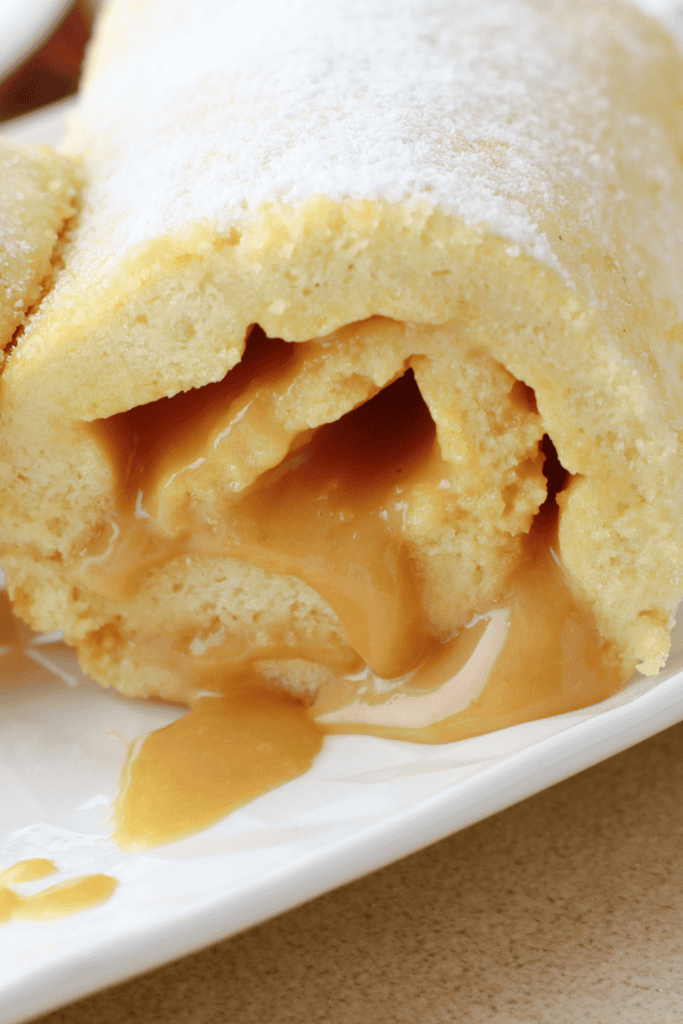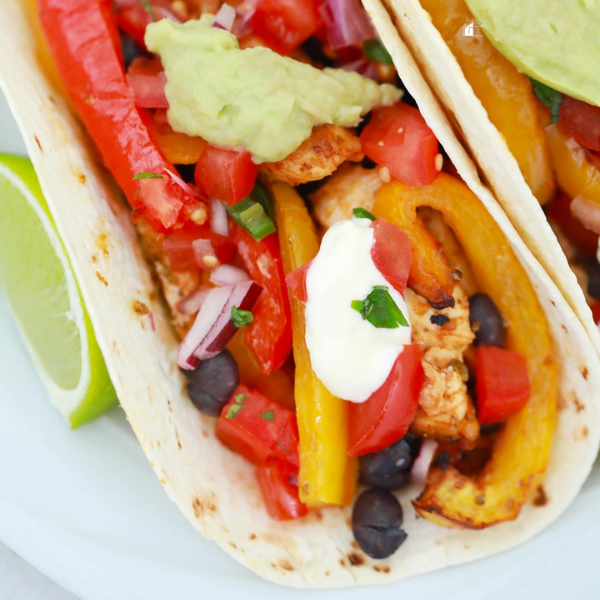Brazo Gitano Recipe (Swiss Roll with Dulce de Leche)
This post may contain affiliate links which might earn us money. Please read my Disclosure and Privacy policies hereBrazo Gitano, also known as a Swiss Roll, is a soft and airy sponge cake filled with creamy dulce de leche, rolled into an elegant spiral, and perfect for any dessert table. This classic treat is a favorite across Spain and Latin America, where it’s cherished for its simplicity and rich flavor. With its melt-in-your-mouth texture and caramel-like filling, it’s a showstopper that looks much harder to make than it actually is.
This rolled cake is versatile and can be paired with a variety of accompaniments to create a complete dessert spread. Consider serving it with fresh strawberries, whipped cream, or even a scoop of vanilla ice cream for a refreshing balance to the dulce de leche’s richness.
If you’re planning a party, Brazo Gitano pairs wonderfully with a creamy flan or a rich chocolate mousse. Whether you’re a beginner or a seasoned baker, this recipe will guide you step by step to create the perfect Brazo Gitano with ease. Let’s get started!

What is Brazo Gitano?
Brazo Gitano, which translates to “gypsy’s arm,” is a light sponge cake rolled around a luscious filling, often dulce de leche, jam, or cream. It’s believed to have originated in Spain and later spread to Latin America, where it became a beloved dessert. The name’s origin is debated, but some say it resembles an arm when rolled into its signature spiral shape.
What sets Brazo Gitano apart is its delicate texture and adaptability. The cake is baked flat, filled, and rolled while still warm to avoid cracks, resulting in a beautiful swirl when sliced. Its flavor varies depending on the filling, making it an endlessly versatile dessert. While similar to the Swiss Roll, Brazo Gitano often uses regional flavors, like guava, coconut, or chocolate, giving it a unique identity.

Ingredients to Make This Recipe
Making Brazo Gitano at home requires just a few simple ingredients, many of which you may already have in your kitchen. Here’s what you’ll need and why each ingredient is important:
- 4 eggs (room temperature): Eggs provide structure and volume to the cake. Using them at room temperature ensures they whip to their fullest potential, creating a light and fluffy texture.
- 90 grams flour: This gives the cake its body and stability. Make sure to sift the flour to avoid lumps and ensure a smooth batter.
- 100 grams sugar: Sugar adds sweetness and helps create a golden-brown crust. Half is used for the egg yolks, and the other half is whipped with the egg whites to create a meringue-like texture.
- 1 teaspoon baking powder: A leavening agent that helps the cake rise evenly and stay light.
- ½ teaspoon salt: Enhances the overall flavor and balances the sweetness.
- 100 grams dulce de leche: The star of the filling, dulce de leche is creamy, caramel-like, and irresistibly rich.
- 2 tablespoons butter (optional): Adds moisture and a slightly richer flavor to the cake.
Each ingredient plays a vital role in achieving the perfect sponge and ensuring your Brazo Gitano is as delicious as it is beautiful.
How to Make Dulce de Leche Swiss Roll Recipe
Making a Brazo Gitano might seem intimidating, but by following these detailed steps, even beginners can achieve a beautiful, professional-looking result.
Step 1: Prepare the baking equipment and preheat the oven
Preheat your oven to 350°F. Take a 9.5 x 11-inch baking pan and line the bottom with parchment paper, ensuring it covers the base completely. This will help the cake release easily after baking.
Step 2: Set up the tea towel
On a clean, flat surface, lay out a damp tea towel. Sprinkle it generously with powdered sugar to prevent the cake from sticking when you roll it later. This step is key for creating a smooth roll.

Step 3: Separate the eggs and prepare the yolk mixture
Separate the eggs into two bowls—one for yolks and one for whites. Using an electric mixer or whisk, beat the egg yolks with half the sugar (50 grams) until the mixture becomes pale, thick, and creamy. This step adds volume and richness to the batter.
Step 4: Whip the egg whites
In a clean bowl, whip the egg whites until soft peaks form. Gradually add the remaining sugar (50 grams) while continuing to beat. Whip until the egg whites hold stiff, glossy peaks. This process traps air, which will help the sponge cake rise without any additional fat.

Step 5: Combine the yolk and white mixtures
Gently fold the whipped egg whites into the yolk mixture using a spatula. This folding technique helps retain the air in the batter, making the cake light and fluffy. Be patient and fold slowly until the two mixtures are fully combined.
Step 6: Add the dry ingredients
Sift the flour, baking powder, and salt together to remove lumps. Gradually add the dry ingredients to the egg mixture, folding gently after each addition. Stop mixing as soon as the batter comes together to avoid deflating it.
Step 7: Pour and level the batter
Pour the batter into the prepared baking pan. Use an offset spatula or the back of a spoon to spread it evenly to the edges. Lightly tap the pan on the counter to release any air bubbles trapped in the batter.
Step 8: Bake the sponge
Place the pan in the preheated oven and bake for 15–18 minutes. Keep an eye on the cake—it’s ready when the top is golden brown and springs back when lightly pressed.

Step 9: Invert and roll the cake
Once baked, remove the cake from the oven and immediately invert it onto the prepared tea towel. Carefully peel off the parchment paper. Starting from the short side of the cake, use the towel to roll the cake gently into a spiral. Allow it to cool completely while rolled up, about 15 minutes. Rolling it while warm prevents cracks.
Step 10: Fill the cake
After the cake has cooled, carefully unroll it. Spread a thin, even layer of dulce de leche over the entire surface of the cake using an offset spatula or butter knife. Be sure to reach the edges for a consistent filling.
Step 11: Re-roll the cake
Once filled, roll the cake back up tightly, this time without the towel. Be gentle to keep the roll intact, but firm enough to ensure a snug spiral.
Step 12: Chill and serve
Place the rolled cake in the refrigerator for at least 30 minutes to allow the filling to set and the cake to firm up. When ready to serve, use a sharp knife to slice the roll into even portions. Enjoy your homemade Brazo Gitano with a drizzle of caramel or a dollop of whipped cream if desired.

Tips for Making Brazo Gitano Recipe
These helpful tips will ensure your Brazo Gitano turns out beautifully:
- Use Room-Temperature Eggs: This helps the eggs whip to their full volume, resulting in a lighter cake.
- Roll While Warm: Rolling the cake while it’s still warm prevents cracks and helps it hold its shape.
- Don’t Overmix: Gently fold the ingredients to avoid deflating the batter.
- Dust Generously: Use plenty of powdered sugar on the tea towel to prevent sticking.
- Chill Before Slicing: Refrigerating the rolled cake allows the filling to set and makes slicing easier.

Frequently Asked Questions
Why is my cake cracking?
Cracks typically happen when the cake cools completely before rolling. Always roll the cake while it’s still warm to keep it pliable. If it does crack, a dusting of powdered sugar or a drizzle of sauce can help hide imperfections.
Can I use a different filling?
Absolutely! While dulce de leche is traditional, you can use whipped cream, chocolate ganache, or fruit preserves. For a lighter version, try a mix of whipped cream and mascarpone.
How long can I store Brazo Gitano?
Store your rolled cake in the refrigerator for up to three days. Wrap it tightly in plastic wrap to keep it fresh and prevent it from drying out.
Can I freeze Brazo Gitano?
Yes, it freezes well! Wrap the cake tightly in plastic wrap, then foil, and store it in the freezer for up to one month. Thaw it in the refrigerator overnight before serving.
Have you tried making Brazo Gitano? If so, we’d love to hear how it turned out! Don’t forget to rate and review this recipe. Your feedback not only helps us but also inspires others to try this delectable dessert. Happy baking!

Brazo Gitano Filled With Dulce De Leche Recipe (Swiss Roll)
Brazo Gitano, also known as Swiss Roll with dulce de leche, is a classic dessert featuring a soft sponge cake rolled around a creamy caramel filling.
This light and elegant treat is perfect for beginners and experienced bakers alike, making it ideal for special occasions or a simple indulgence at home.
With its golden sponge and rich dulce de leche, this recipe is as satisfying to make as it is to eat.
Ingredients
- 4 eggs (room temperature)
- 90 grams flour
- 100 grams sugar
- 1 teaspoon baking powder
- ½ teaspoon salt
- 100 grams dulce de leche
- 2 tablespoons butter (optional)
Instructions
- Prepare the oven and pan: Preheat your oven to 350°F. Line the bottom of a 9.5 x 11-inch baking pan with parchment paper, ensuring it covers the base completely. This will prevent the cake from sticking.
- Set up the rolling towel: On a clean surface, lay out a slightly damp tea towel. Sprinkle it generously with powdered sugar. This will help the cake release easily and prevent sticking when rolling it.
- Separate the eggs: Crack the eggs and separate the yolks and whites into two large mixing bowls.
- Beat the egg yolks: Add half of the sugar (50 grams) to the egg yolks. Using a whisk or an electric mixer, beat until the mixture becomes pale and thick, almost like a creamy pudding.
- Whip the egg whites: In the second bowl, use a clean whisk or mixer to beat the egg whites until they form soft peaks (when you lift the whisk, the mixture should form peaks that slightly fold over). Gradually add the remaining sugar (50 grams) and continue beating until the peaks are stiff and glossy.
- Combine the egg mixtures: Gently fold the whipped egg whites into the yolk mixture. Use a spatula and fold in a scooping motion from the bottom up to avoid deflating the air in the egg whites.
- Incorporate the dry ingredients: In a separate bowl, sift together the flour, baking powder, and salt to remove any lumps. Slowly add the dry ingredients into the egg mixture, folding gently after each addition. Do not overmix; the batter should remain light and airy.
- Pour the batter into the pan: Pour the batter into the prepared baking pan. Use an offset spatula or the back of a spoon to spread it evenly to the edges. Tap the pan lightly on the counter a few times to remove air bubbles.
- Bake the cake: Place the pan in the oven and bake for 15–18 minutes. The cake is ready when the top is golden brown and it springs back when lightly pressed.
- Invert the cake: Remove the cake from the oven and immediately flip it onto the prepared tea towel. Carefully peel off the parchment paper to avoid tearing the cake.
- Roll the warm cake: Starting at the short end, use the towel to gently roll the cake into a spiral. The towel will support the cake as it sets into its shape. Leave the rolled cake to cool on a wire rack for about 15 minutes.
- Unroll and fill: After cooling, carefully unroll the cake. Spread a thin, even layer of dulce de leche over the entire surface using a butter knife or offset spatula. Make sure the filling reaches all edges for an even flavor.
- Re-roll the filled cake: Roll the cake back up tightly without the towel, starting at the same short end. Be gentle to keep the sponge intact, but firm enough to create a snug spiral.
- Chill before serving: Place the rolled cake in the refrigerator for at least 30 minutes. This helps the dulce de leche set and makes the cake easier to slice.
- Slice and serve: When ready to serve, use a sharp knife to cut the cake into even slices. Enjoy your homemade Brazo Gitano with a sprinkle of powdered sugar or a dollop of whipped cream!
Notes
Use room-temperature eggs: They whip better and create more volume, making the sponge light and fluffy.
Be gentle when folding: Overmixing the batter can deflate the air, resulting in a dense cake. Use slow, folding motions to preserve the texture.
Roll while warm: Rolling the cake while it’s still warm prevents cracks and helps it hold its shape. Be sure to use a towel sprinkled with powdered sugar to avoid sticking.
Adjust the filling: While dulce de leche is traditional, you can use whipped cream, fruit preserves, or chocolate ganache as alternatives.
Cool completely before slicing: Chilling the rolled cake allows the filling to set and makes it easier to cut neat slices.
Storage tips: Wrap leftovers in plastic wrap and store in the refrigerator for up to three days. For longer storage, freeze the cake for up to one month. Thaw in the refrigerator before serving.
Customization: Dust the finished cake with powdered sugar, drizzle with caramel, or top with fresh fruit for added flair.
Recommended Products
As an Amazon Associate and member of other affiliate programs, I earn from qualifying purchases.
Nutrition Information:
Yield: 10 Serving Size: 1Amount Per Serving: Calories: 152Total Fat: 5gSaturated Fat: 3gTrans Fat: 0gUnsaturated Fat: 2gCholesterol: 83mgSodium: 214mgCarbohydrates: 23gFiber: 0gSugar: 15gProtein: 4g
These nutritional calculations might not be accurate. Please speak with a licensed nutritionist to assist you.












